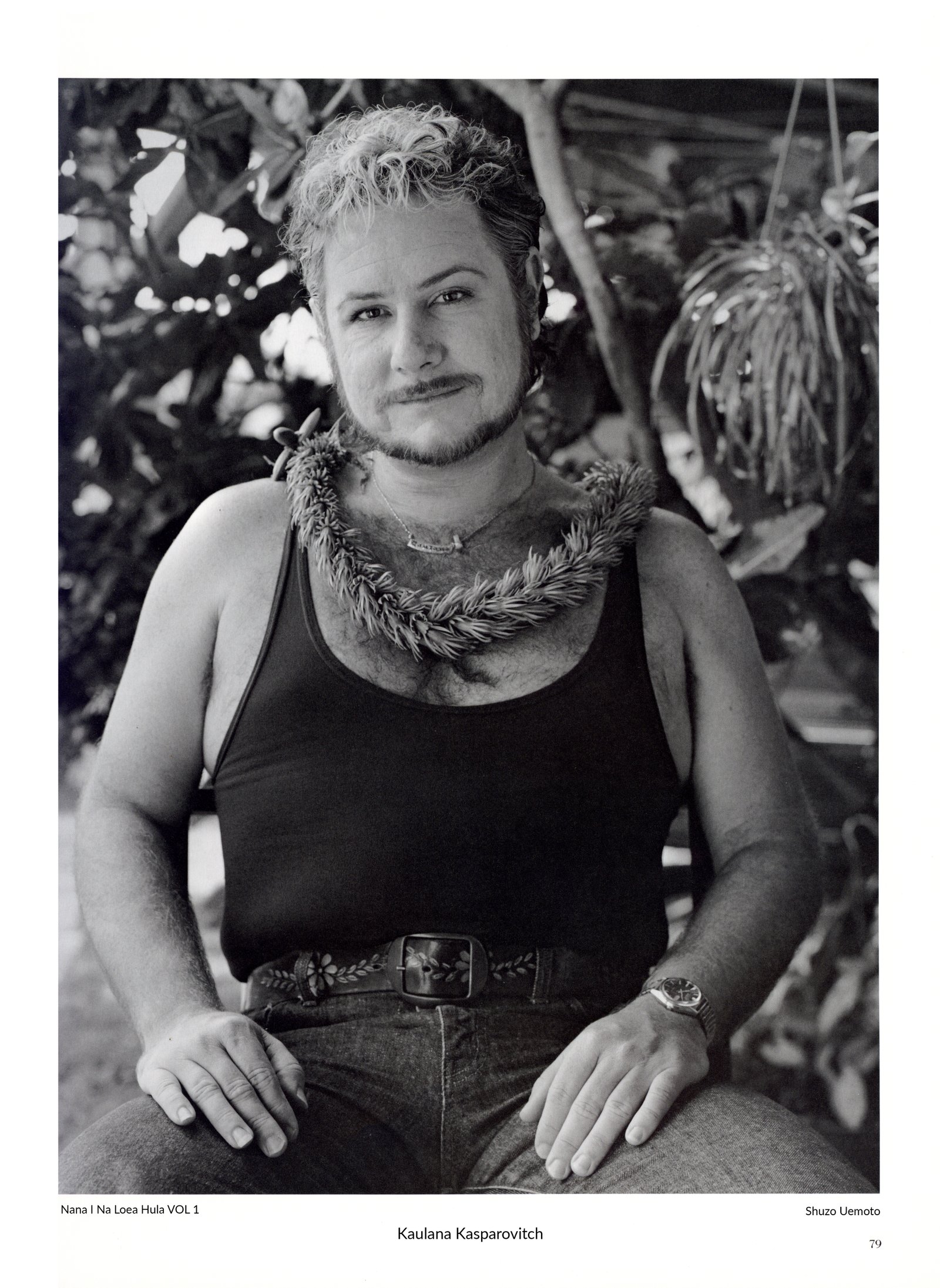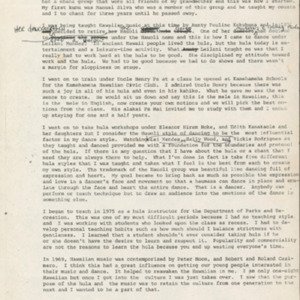Kaulana Kasparovitch
Title
Kaulana Kasparovitch
Description
Kaulana Kasparovitch
Originally trained in fine arts and classical music, Kaulana Kasparovitch established the Lehua Dance Company and has taught the hula for the past eight years in Honolulu.
We are close to a point of saturation in the hula right now unless there is something new that arises to keep the next generation interested. In any culture you will have peaks and valleys. In the next three to five years the interest in the culture will level off and possibly turn downward. Other things will arise because today Hawaiʻi is cosmopolitan.
My grandmother Minnie Liliaokalani Wilhem Jones was the one that saw to it that I was introduced to Hawaiian music and dance. She introduced me to a lovely lady named Emily Thomas who had an ‘ohana group that were all friends of my grandmother and this was how I started. My first kumu was Manuel Silva who was a member of this group and he taught my cousin and I to chant for three years until he passed away.
I was being taught Hawaiian music at this time by Aunty Pauline Kekahuna and in 1971 her dancers decided to retire from the Hau’oli group. Aunty Pauline and one of her musicians decided to open a hālau under the Hau‘oli name and this is how I came to dance under Leilani Mendez. In ancient Hawai‘i people lived the hula, but the hula today is entertainment and a leisure-time activity. What Leilani taught me was that I really had to work hard at the hula to be good. She disciplined my attitude toward work and hula. We had to be good because we had to do shows and there wasn’t a margin for sloppiness on stage.
I went on to train under Uncle Henry Pa at a class he opened at Kamehameha Schools for the Kamehameha Hawaiian Civic Club. I admired Uncle Henry because there was such a joy in all of his hula and even in his kahiko. What he gave me was the essence to create. He would sit us down and say this is the mele in Hawaiian, this is the mele in English, now create your own motions and we will pick the best motions from the class. His alakaʻi Pa Mai invited me to study with them and I ended up staying for one and a half years.
I went on to take hula workshops under Eleanor Hiram Hoke, and Edith Kanaka’ole and her daughters but I consider the Hau‘oli style of dancing to be the most influential factor in my dance style. Watching Vickie Iʻi Rodrigues, Lei Mendez, and Sally Wood Nāluaʻi as they taught and danced provided me with a foundation for the boundaries and protocol of the hula. If there is any question that I have about the hula or a chant that I need they are always there to help. What I’ve done in fact is take five different hula styles that I was taught and taken what I feel is the best from each to create my own style. The trademark of the Hauʻoli group was beautiful line dancing full of expression and heart. My goal became to bring back as much as possible the expression and love in a dancer’s face and movement so that a haumāna can dance in place and emulate through the face and heart the entire dance. That is a dancer. Anybody can perform or teach technique but to draw an audience into the emotions of the dance is something else.
I began to teach in 1975 as a hula instructor for the Department of Parks and Recreation. This was one of my most difficult periods because I had no teaching style and I was working with students who looked upon the class as recess. I had to develop personal teaching habits such as how much should I balance strictness with gentleness. I learned that a student shouldn’t ever consider taking hula if he or she doesn’t have the desire to learn and respect it. Popularity and commerciality are not the reasons to learn the hula because you end up wasting everyone’s time.
In 1969 Hawaiian music was contemporized by Peter Moon, and Robert and Roland Cazimero. I think this had a great influence on getting our young people interested in their music and dance. It helped to reawaken the Hawaiian in me. I am only one-eighth Hawaiian but once I got into the culture I was just taken over. I saw that the purpose of the hula and the music was to retain the culture from one generation to the next and I wanted to be a part of that.
Originally trained in fine arts and classical music, Kaulana Kasparovitch established the Lehua Dance Company and has taught the hula for the past eight years in Honolulu.
We are close to a point of saturation in the hula right now unless there is something new that arises to keep the next generation interested. In any culture you will have peaks and valleys. In the next three to five years the interest in the culture will level off and possibly turn downward. Other things will arise because today Hawaiʻi is cosmopolitan.
My grandmother Minnie Liliaokalani Wilhem Jones was the one that saw to it that I was introduced to Hawaiian music and dance. She introduced me to a lovely lady named Emily Thomas who had an ‘ohana group that were all friends of my grandmother and this was how I started. My first kumu was Manuel Silva who was a member of this group and he taught my cousin and I to chant for three years until he passed away.
I was being taught Hawaiian music at this time by Aunty Pauline Kekahuna and in 1971 her dancers decided to retire from the Hau’oli group. Aunty Pauline and one of her musicians decided to open a hālau under the Hau‘oli name and this is how I came to dance under Leilani Mendez. In ancient Hawai‘i people lived the hula, but the hula today is entertainment and a leisure-time activity. What Leilani taught me was that I really had to work hard at the hula to be good. She disciplined my attitude toward work and hula. We had to be good because we had to do shows and there wasn’t a margin for sloppiness on stage.
I went on to train under Uncle Henry Pa at a class he opened at Kamehameha Schools for the Kamehameha Hawaiian Civic Club. I admired Uncle Henry because there was such a joy in all of his hula and even in his kahiko. What he gave me was the essence to create. He would sit us down and say this is the mele in Hawaiian, this is the mele in English, now create your own motions and we will pick the best motions from the class. His alakaʻi Pa Mai invited me to study with them and I ended up staying for one and a half years.
I went on to take hula workshops under Eleanor Hiram Hoke, and Edith Kanaka’ole and her daughters but I consider the Hau‘oli style of dancing to be the most influential factor in my dance style. Watching Vickie Iʻi Rodrigues, Lei Mendez, and Sally Wood Nāluaʻi as they taught and danced provided me with a foundation for the boundaries and protocol of the hula. If there is any question that I have about the hula or a chant that I need they are always there to help. What I’ve done in fact is take five different hula styles that I was taught and taken what I feel is the best from each to create my own style. The trademark of the Hauʻoli group was beautiful line dancing full of expression and heart. My goal became to bring back as much as possible the expression and love in a dancer’s face and movement so that a haumāna can dance in place and emulate through the face and heart the entire dance. That is a dancer. Anybody can perform or teach technique but to draw an audience into the emotions of the dance is something else.
I began to teach in 1975 as a hula instructor for the Department of Parks and Recreation. This was one of my most difficult periods because I had no teaching style and I was working with students who looked upon the class as recess. I had to develop personal teaching habits such as how much should I balance strictness with gentleness. I learned that a student shouldn’t ever consider taking hula if he or she doesn’t have the desire to learn and respect it. Popularity and commerciality are not the reasons to learn the hula because you end up wasting everyone’s time.
In 1969 Hawaiian music was contemporized by Peter Moon, and Robert and Roland Cazimero. I think this had a great influence on getting our young people interested in their music and dance. It helped to reawaken the Hawaiian in me. I am only one-eighth Hawaiian but once I got into the culture I was just taken over. I saw that the purpose of the hula and the music was to retain the culture from one generation to the next and I wanted to be a part of that.
Citation
“Kaulana Kasparovitch,” Nā Kumu Hula Archive, accessed November 28, 2025, https://nakumuhula.org/archive/items/show/59.


